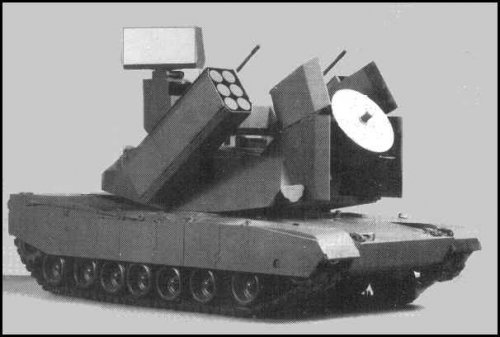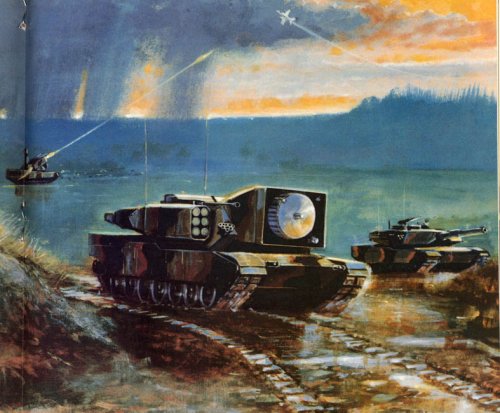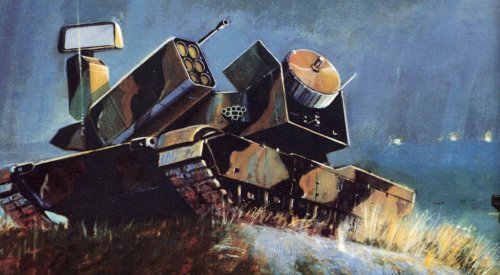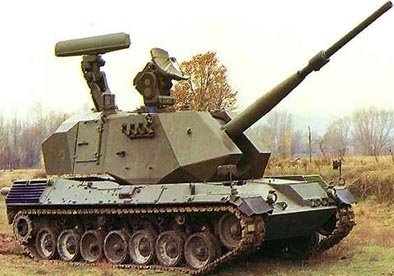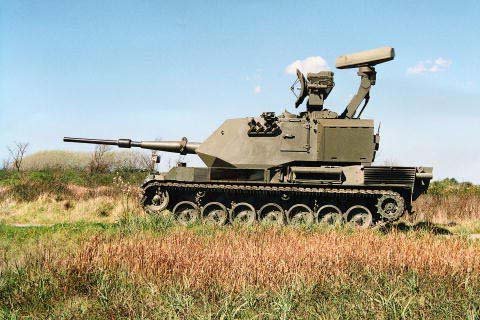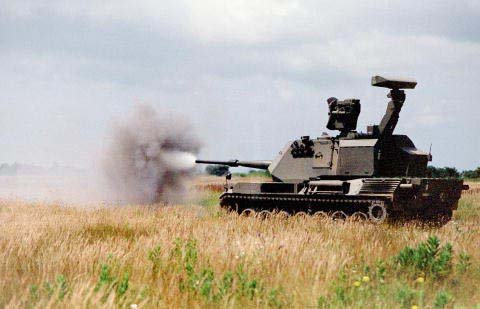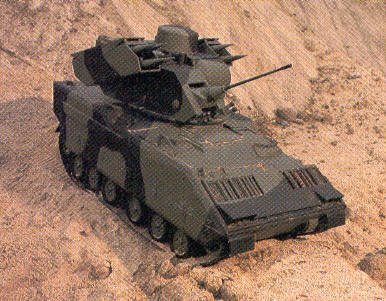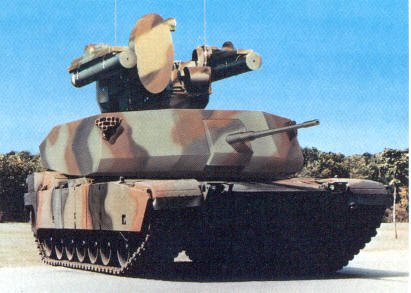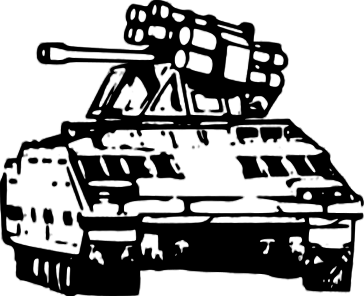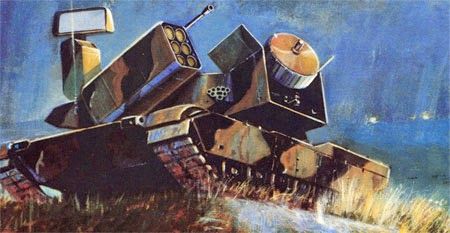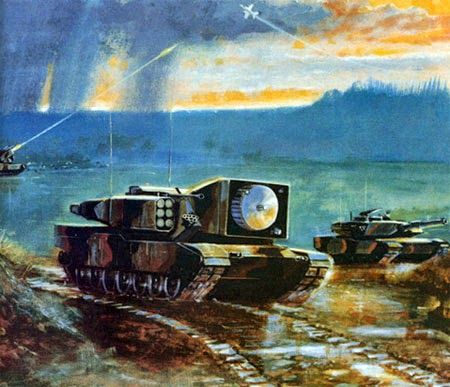You are using an out of date browser. It may not display this or other websites correctly.
You should upgrade or use an alternative browser.
You should upgrade or use an alternative browser.
- Joined
- 3 June 2011
- Messages
- 17,332
- Reaction score
- 9,067
Found a few more pictures in an old magazine. This was proposed as part of the Line Of Site Forward Heavy program from the mid 80s. Liberty was based on the Shahine/Crotale firing unit mounted on an Abrams chassis with 12 rounds loaded and had two 25mm guns. Thomson CSF and LTV was the team proposing it.
IIRC xxxxxx (an OTO 76mm Super Rapid mounted on a Leopard I chassis) was also in the mix.
IIRC xxxxxx (an OTO 76mm Super Rapid mounted on a Leopard I chassis) was also in the mix.
Attachments
Wasn't Trinity an advanced Bofors 40mm?IIRC Trinity (an OTO 76mm Super Rapid mounted on a Leopard I chassis) was also in the mix.
- Joined
- 3 June 2011
- Messages
- 17,332
- Reaction score
- 9,067
smurf said:Wasn't Trinity an advanced Bofors 40mm?IIRC Trinity (an OTO 76mm Super Rapid mounted on a Leopard I chassis) was also in the mix.
Yeah, I'm going to have to go hunt down the name again. Wouldn't be the first time more than one project had the same name but I'll check it out.
- Joined
- 3 June 2011
- Messages
- 17,332
- Reaction score
- 9,067
sferrin said:This was an air defense system based on the M1 chassis. ISTR it had two 25mm guns and ADATS missiles but I can't find anything on it.
I have a PDF on my computer describing it but I can't remember where I initially got it. Here's a text version of the article though. Pair of 35mm Bushmaster III instead of 25mm though. I'll upload the images in the article that aren't in that version later today.
sferrin said:You sure on the 35mm? The guns on the model look too small to be 35mm. Tiny compared to the 35mm on a Gepard anyway. ???
Actually, looking at the article again, it looks like its a different M1 SPAAG proposal. My bad.
- Joined
- 27 March 2006
- Messages
- 1,793
- Reaction score
- 1,308
sferrin said:Not sure if this is the same program or a different interation of the same concept but it appears it at least got to hardware and was called "OTOMATIC".
That's the Oto-Melara 76mm Project from the early 1980's. Used the ordinance from the Italian naval gun of the same calibre. It never found a client. Interesting concept to try and take the hitting power out to beyond helicopter ATGM range.
The Rooikat uses a 76mm derived from the same naval gun, but not in automatic.
JAZZ
ACCESS: Secret
- Joined
- 11 March 2006
- Messages
- 302
- Reaction score
- 251
Another gun-missile combination proposed for the americans was the rapier-25mm turret on a Bradley IFV - from an article which also covered the liberty - Thomson CSF and LTV proposal.
There was another 25mm-Roland combination called paladin
There was another 25mm-Roland combination called paladin
Attachments
- Joined
- 25 July 2007
- Messages
- 3,873
- Reaction score
- 3,178
A few details on the FAADS Liberty.
Liberty (White Sands firing trials): AMX-30 hull mounting 6 x Shahine missiles; surveillance radar, a multisensor fire control suite with a tracking radar, FLIR, TV, and integrated IFF.
Liberty I: M1A1 mounting either 6 x Shahine or 12 x VT-1 Liberty missiles and 2 x .50 cal mgs. Called FAADS-M1 by GDLS.
If selected, Liberty I would be the first batch. Liberty II would follow 18 months later.
Liberty II: M1A1 mounting 12 x Liberty missiles and 2 x 25mm Bushmaster. Missiles, TSR 2630 radar antenna, and other systems would be under armour. Mach 3.5 peak velocity and 10 km range for missiles. Crew of two, 27.2 tonnes.
Bradley and M113 Liberty mounts are also mentioned on the JED site.
Other LOS-Forward-Heavy competitors were Martin Marietta/Oerlikon Aerospace with ADATS, (and as JAZZ said) Hughes/Euromissile with Paladin (a Roland development), and UADS (UT/BAe/FMC) with the Advanced Rapier. ADATS won the contest (becoming MIM-146A) but was, of course, cancelled in 1992.
ADATS was to be M113A2-mounted with "Bradley ADATS" to follow. Advanced Rapier was to be similar. "Tracked Rapier" (M113-mount, I think) followed by "Bradley Rapier".
[Mod: The test Paladin mount (with Roland 2s) was to be the M109 hull. Production version would have been Roland 2 or 3 on a Bradley hull. -- JDW Vol7 Issue 24 (21 June 1987)]
Liberty (White Sands firing trials): AMX-30 hull mounting 6 x Shahine missiles; surveillance radar, a multisensor fire control suite with a tracking radar, FLIR, TV, and integrated IFF.
Liberty I: M1A1 mounting either 6 x Shahine or 12 x VT-1 Liberty missiles and 2 x .50 cal mgs. Called FAADS-M1 by GDLS.
If selected, Liberty I would be the first batch. Liberty II would follow 18 months later.
Liberty II: M1A1 mounting 12 x Liberty missiles and 2 x 25mm Bushmaster. Missiles, TSR 2630 radar antenna, and other systems would be under armour. Mach 3.5 peak velocity and 10 km range for missiles. Crew of two, 27.2 tonnes.
Bradley and M113 Liberty mounts are also mentioned on the JED site.
Other LOS-Forward-Heavy competitors were Martin Marietta/Oerlikon Aerospace with ADATS, (and as JAZZ said) Hughes/Euromissile with Paladin (a Roland development), and UADS (UT/BAe/FMC) with the Advanced Rapier. ADATS won the contest (becoming MIM-146A) but was, of course, cancelled in 1992.
ADATS was to be M113A2-mounted with "Bradley ADATS" to follow. Advanced Rapier was to be similar. "Tracked Rapier" (M113-mount, I think) followed by "Bradley Rapier".
[Mod: The test Paladin mount (with Roland 2s) was to be the M109 hull. Production version would have been Roland 2 or 3 on a Bradley hull. -- JDW Vol7 Issue 24 (21 June 1987)]
Strange that the West never fielded a tracked air defence system less the Gepard when the Soviet Bloc had the ZSU-24 and later the 2S16 Tunguska. I suppose Hawk AA batteries and Stinger MANPADS were the way to go and were latter replaced by the Patriot Weapon System.
What about the M163 Vulcan Air Defense System (VADS) or it's Israeli Machbet derivative?



On the missile only front you also have the AM-30 Roland derivative:

Regards,
Greg
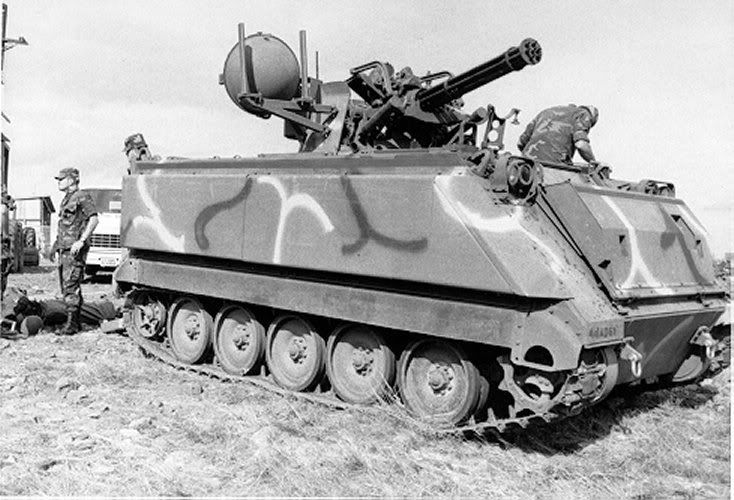
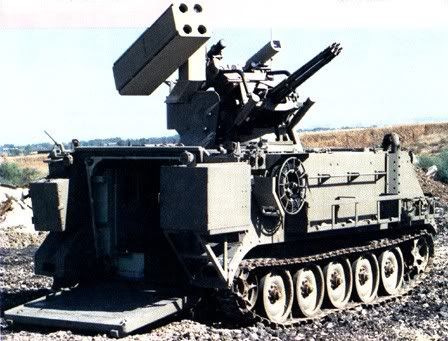
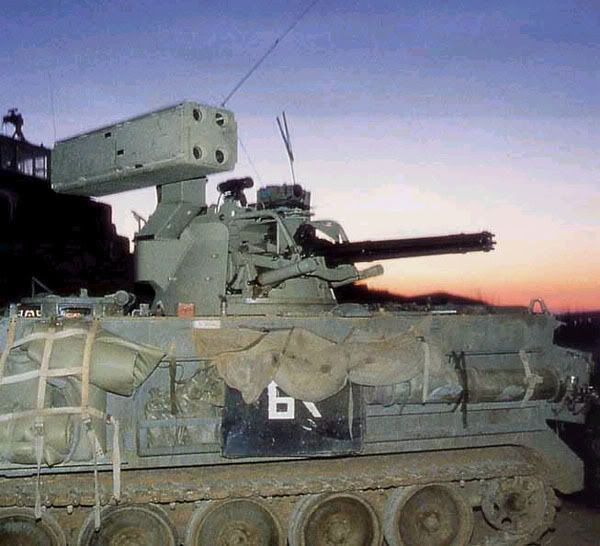
On the missile only front you also have the AM-30 Roland derivative:
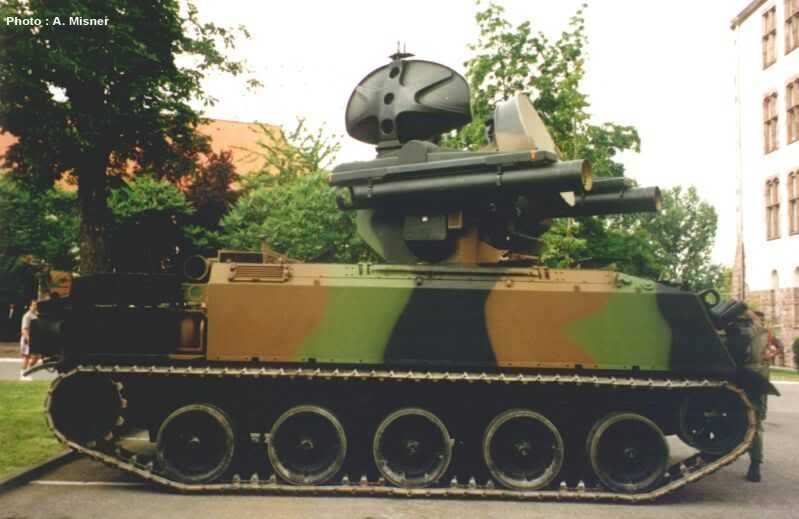
Regards,
Greg
Mercurius Cantabrigiensis
ACCESS: Restricted
- Joined
- 8 November 2007
- Messages
- 46
- Reaction score
- 17
amsci99 said:Strange that the West never fielded a tracked air defence system less the Gepard when the Soviet Bloc had the ZSU-24 and later the 2S16 Tunguska.
There was the ill-fated US Roland programme in the late 1970s in which the European SAM system was extensively redesigned at subsystem/module level to conform to US engineering practice. The entire project was steadily given the budgetary 'death of a thousand cuts' until only a handful of units were built and issued only the National Guard.
gollevainen
ACCESS: Confidential
- Joined
- 2 May 2007
- Messages
- 131
- Reaction score
- 168
Is there any images of the cancelled Mauler SAM system, the one that led soviets to developt the OSA (SA-8 Gecko)??
The OTOMATIC it's re-born as Multifunctional Weapons System on turret for Centauro, Dardo or equivalent. The MWS can fire the new guided ammo DART of naval Davide/Strales systemsferrin said:Not sure if this is the same program or a different interation of the same concept but it appears it at least got to hardware and was called "OTOMATIC".
http://www.nxtbook.com/nxtbooks/aw/dti0908/index.php?startid=20
other picture of the old OTOMATIC


- Joined
- 26 January 2011
- Messages
- 2,223
- Reaction score
- 492
gollevainen said:Is there any images of the cancelled Mauler SAM system, the one that led soviets to developt the OSA (SA-8 Gecko)??
Yes.

That image appears a bit distorted to me. The next one is better and clearer:
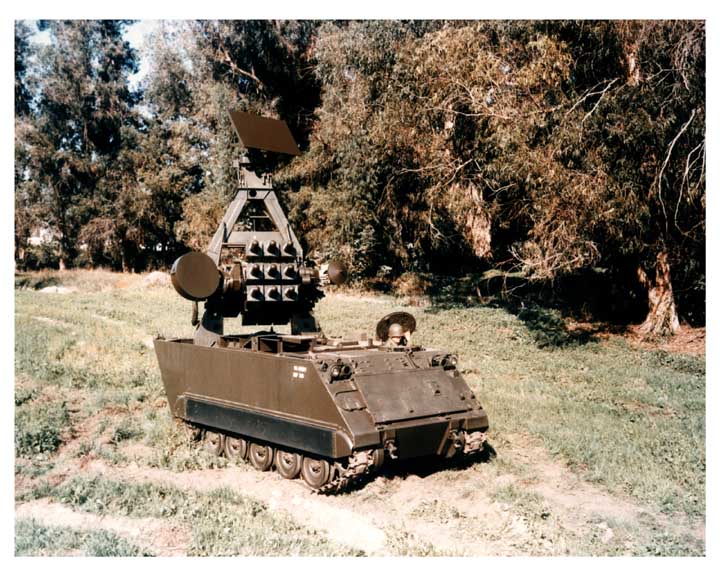
Lampshade111
ACCESS: Confidential
- Joined
- 5 October 2008
- Messages
- 151
- Reaction score
- 12
Can anybody enlighten me on the relationship of the VT-1 Liberty missile to the Crotale NG system?
Were the twin 25mm autocannons on the definite Libery FAADS hooked up to the radar fire control system? Or where they just intended to be used against helicopters and ground targets?
Were the twin 25mm autocannons on the definite Libery FAADS hooked up to the radar fire control system? Or where they just intended to be used against helicopters and ground targets?
- Joined
- 9 October 2009
- Messages
- 19,970
- Reaction score
- 10,457
Mercurius Cantabrigiensis said:amsci99 said:Strange that the West never fielded a tracked air defence system less the Gepard when the Soviet Bloc had the ZSU-24 and later the 2S16 Tunguska.
There was the ill-fated US Roland programme in the late 1970s in which the European SAM system was extensively redesigned at subsystem/module level to conform to US engineering practice. The entire project was steadily given the budgetary 'death of a thousand cuts' until only a handful of units were built and issued only the National Guard.
1. Army Programs
a. ROLAND Air Defense Missile System
In 1974 the US selected the French-German designed ROLAND II
air defense missile system instead of developing a new US short range
air defense system. Hughes Aircraft Corporation won the bid for
technology transfer, fabrication and test of the US ROLAND. The
three countries have established a joint control committee to insure
a maximum level of standardization between the European and American
configurations, and Norway plans to purchase the US version. ROLAND
entered into production in Europe in 1977, and a US production decision
will be made in 1978. Unanticipated difficulties in the exchange and
translation of detailed technical information, resulting in some US
timetable delays and cost increases, have now been resolved with data
transfer essentially complete.
The restructured program approved by OSD in December 1976
with total RDTE expenditure is planned at $276 million.
b. Short-Range Air Defense
1) ROLAND
ROLAND will replace the fair-weather/daylight
CHAPARRAL system in the Corps and rear areas and is required to
counter the increasing night/adverse weather air threat. The
ROLAND RDT&E program consists of a technology transfer and fabrication
effort from Europe (French/German). The program is a
significant U.S. effort to adopt a foreign-developed major weapon
system to U.S. fabrication and will, therefore, have a major impact
on the future success of weapon system cooperation and standardization
with our NATO Allies. The restructured technology transfer,
fabrication and test (TTF&T) program was approved in December 1976
and is proceeding on schedule to a planned production decision in
September 1978. The first two U.S.-produced missiles were successfully
fired from French-built fire units in December 1977. During the
FY 1978 Appropriation Hearings, the Congress directed that $11.4
million in procurement effort be transferred to the RDT&E program
with appropriate adjustments in funds. Total development cost is now
estimated at $276.4 million (previous $265 million plus $11.4 million).
The FY 1979 RDT&E request is $22.7 million, and the procurement
request Is $200.1 million.
THE FY 1979 DEPARTMENT OF DEFENSE PROGRAM FOR RESEARCH, DEVELOPMENT, AND ACQUISITION
Kadija_Man said:gollevainen said:Is there any images of the cancelled Mauler SAM system, the one that led soviets to developt the OSA (SA-8 Gecko)??
Yes.

That image appears a bit distorted to me. The next one is better and clearer:

What were the dimensions of the Mauler system when closed down for travel?
- Joined
- 9 October 2009
- Messages
- 19,970
- Reaction score
- 10,457
Again on the subject of Roland, and western tracked air defence systems in general:
found what you were looking for in the Gepard book6.1 Air Defense Missile Systems based upon the Leopard Main Battle Tank (Studies)
In 1978, under contract by the Dutch Company, Hollandse Signaalapparaten BV., Krauss-Maffei completed a feasibility design study. The objective of the study was to investigate mounting a surface-to-air Missile Tank Turret on a modified Leopard MBT chassis. Three different types of missiles were considered:
6.1.1. "Roland" Surface-to-Air Missile Turret
By considerable retention of most of the standard CA 1 turret, a fully autonomous, air defense missile system was created. In all it was planned that the complete system would carry ten, ready-to-fire "Roland" Anti-Aircraft Missiles. Besides which, for self-defense purposes two 7.62 mm FN Machine Guns and two "Swingfire" Anti-Tank Missiles were proposed. The three man crew concept of the CA 1 was retained. In the roof of the turret the standard Gunner's periscope was replaced by an optronic missile Tracking Unit.
6.1.2. "Rapier" Surface-to-Air Missile Turret
Also with this concept the CA 1 turret remained practically unchanged, two laterally mounted missile launchers replacing the 35 mm cannon. Each launcher containing five of these British developed surface-to-air missiles ready to fire. The means of self-defense which were provided being identical which were proposed for the "Roland" concept. Again the standard Gunner's periscope was replaced by an Optronic Tracking Unit.
6.1.3. "Chaparral" Surface-to-Air Missile Turret
The "Chaparral" lightweight, supersonic, surface-to-air missile requires no guidance after launching, an infrared target seeker head serves this purpose. "Chaparral" is a derivative of the "Sidewinder" AIM-9D air-to-air missile. Eight "Chaparral" missiles (4 on each side) could be stowed in armored launchers on the almost standard CA 1 turret (Guns removed as in both other concepts). Once again, for self-defense purposes two "Swingfire" Anti-Tank Missiles were included in the concept. As target tracking was unnecessary due to the missile infrared seeker, the Gunner periscope remained standard, only an additional "black-box" adaptor was necessary for providing guidance for the "Swingfire" missiles.
- Joined
- 9 October 2009
- Messages
- 19,970
- Reaction score
- 10,457
Last edited:
- Joined
- 9 October 2009
- Messages
- 19,970
- Reaction score
- 10,457
(References left out for clarity)The Secretary of Defense's 1985 cancellation of the SGT York Air Defense Gun dealt a serious blow to the Army Air Defense community's plan to correct serious materiel deficiencies for air defense of divisional forces in the forward area. Long an area of insignificant Army resourcing, forward area air defense drew increasing attention during the 1970-1980 period with the recognition of rapidly-growing Soviet air capabilities. In particular, Soviet attention to, and resourcing of, a family of heavily-armed antitank helicopters highlighted the problem of inadequate active air defenses for the division. Threat community projections of the ability of future Soviet helicopters to hover and engage at stand-off ranges doomed the expensive and problem-riddled SGT York program. Yet with that cancellation, the Department of Defense further widened the serious vulnerability gap between US maneuver force air defense capabilities and the air threats targeted against them.
In recognition of the seriousness of the problem, the Secretary of Defense directed a thorough combined arms audit of forward area air defense threats and capabilities. This priority study resulted in the his 1986 approval of the FAADS Program. Far more than a substitute for the SGT York, FAADS represented long overdue recognition by the Defense community that air defense of divisional forces was, and remains, a serious deficiency warranting priority resourcing. From the SGT York test, the Defense community learned that "one weapon alone, or even multiple weapons acting independently, cannot defeat the air threat." FAADS Is consequently based on a "system of systems" which Integrates five complementary components: a Line-of-Sight Forward (LOS-F) (Heavy) system; a Line-of-Sight Rear (LOS-R) system; a Non-Line-of-Sight (NLOS) system; an ADA C3 System; and a Combined Arms Initiative (CAI) element by which non-ADA battlefield systems gain enhanced anti-air capabilities.
- Joined
- 21 May 2006
- Messages
- 2,709
- Reaction score
- 1,631
Thanks Grey Havoc, very interesting and confronting. Confronting because even though 'In recognition of the seriousness of the problem and priority' identified by the Secretary of Defense; the basic and fundimental need and requirement has still been ignored and played down by the U.S. till this day!!!(References left out for clarity)The Secretary of Defense's 1985 cancellation of the SGT York Air Defense Gun dealt a serious blow to the Army Air Defense community's plan to correct serious materiel deficiencies for air defense of divisional forces in the forward area. Long an area of insignificant Army resourcing, forward area air defense drew increasing attention during the 1970-1980 period with the recognition of rapidly-growing Soviet air capabilities. In particular, Soviet attention to, and resourcing of, a family of heavily-armed antitank helicopters highlighted the problem of inadequate active air defenses for the division. Threat community projections of the ability of future Soviet helicopters to hover and engage at stand-off ranges doomed the expensive and problem-riddled SGT York program. Yet with that cancellation, the Department of Defense further widened the serious vulnerability gap between US maneuver force air defense capabilities and the air threats targeted against them.
In recognition of the seriousness of the problem, the Secretary of Defense directed a thorough combined arms audit of forward area air defense threats and capabilities. This priority study resulted in the his 1986 approval of the FAADS Program. Far more than a substitute for the SGT York, FAADS represented long overdue recognition by the Defense community that air defense of divisional forces was, and remains, a serious deficiency warranting priority resourcing. From the SGT York test, the Defense community learned that "one weapon alone, or even multiple weapons acting independently, cannot defeat the air threat." FAADS Is consequently based on a "system of systems" which Integrates five complementary components: a Line-of-Sight Forward (LOS-F) (Heavy) system; a Line-of-Sight Rear (LOS-R) system; a Non-Line-of-Sight (NLOS) system; an ADA C3 System; and a Combined Arms Initiative (CAI) element by which non-ADA battlefield systems gain enhanced anti-air capabilities.
Regards
Pioneer
shin_getter
ACCESS: Top Secret
- Joined
- 1 June 2019
- Messages
- 941
- Reaction score
- 1,198
I find it kind of unbelievable that a project like this have not been revived and pushed with a big budget, outside of Russia.
A few things:
1. Modern runway independent air threats can not be effectively neutralized by traditional air superiority or long range area air defense. Some kind of short ranged land based system is almost required for safe maneuver.
2. Wheeled and unarmored systems lack mobility and survivability to match up with "heavy formations." With only wheeled systems the entire formation can be locked onto roads and those very expensive systems can be totaled against light artillery fire or micro-munitions, certain to be attempted by any battle-networked equipped opponent.
3. Historical systems before MAV/PGM revolution is likely inefficient and ineffective and new designs leveraging modern AESA radars, DEW, guided cannon munitions does offer a path to superior performance.
A few things:
1. Modern runway independent air threats can not be effectively neutralized by traditional air superiority or long range area air defense. Some kind of short ranged land based system is almost required for safe maneuver.
2. Wheeled and unarmored systems lack mobility and survivability to match up with "heavy formations." With only wheeled systems the entire formation can be locked onto roads and those very expensive systems can be totaled against light artillery fire or micro-munitions, certain to be attempted by any battle-networked equipped opponent.
3. Historical systems before MAV/PGM revolution is likely inefficient and ineffective and new designs leveraging modern AESA radars, DEW, guided cannon munitions does offer a path to superior performance.
Last edited:
I agree that the West has been very short sighted regarding ground based air defences, in my opinion it is based on an arrogant presumption that we will always operate with air superiority, a prime example of hope foitr the best, ignore the worst.
It always amazes me that the US is only using Stinger as its point air defence, despite the numerous failed attempts; Mauler, Roland and ADATS and the only system to have entered service Chaparral has been withdrawn.
I know the we -the UK - have improved our ground based performance with the introduction of CAMM increasing range from 6 to 15 miles, but I have a gut feeling that the CAMM system is more cumbersome than Rapier. Also I have not read anywhere if the RAF regiment is adopting CAMM to defend airfields, if they are ,I would suggest using CAMM ER which means they could undertake a degree of area defence as well as defending airfields. However, I actually think that the airfield should be protected by the land based ASTER 30's which would provide a more comprehensive national air defence.
It always amazes me that the US is only using Stinger as its point air defence, despite the numerous failed attempts; Mauler, Roland and ADATS and the only system to have entered service Chaparral has been withdrawn.
I know the we -the UK - have improved our ground based performance with the introduction of CAMM increasing range from 6 to 15 miles, but I have a gut feeling that the CAMM system is more cumbersome than Rapier. Also I have not read anywhere if the RAF regiment is adopting CAMM to defend airfields, if they are ,I would suggest using CAMM ER which means they could undertake a degree of area defence as well as defending airfields. However, I actually think that the airfield should be protected by the land based ASTER 30's which would provide a more comprehensive national air defence.
- Joined
- 18 May 2019
- Messages
- 636
- Reaction score
- 1,570
Bradley ADATS testing:
28 September - 01 October 1987 QUH-1 Full Scale Rotary Wing Target testing Line of Sight Forward Heavy (LOS-FH), maneuvers, and flare deployment
28 September - 01 October 1987 QUH-1 Full Scale Rotary Wing Target testing Line of Sight Forward Heavy (LOS-FH), maneuvers, and flare deployment
Last edited:
Kat Tsun
I really should change my personal text
- Joined
- 16 June 2013
- Messages
- 1,126
- Reaction score
- 1,258
I agree that the West has been very short sighted regarding ground based air defences, in my opinion it is based on an arrogant presumption that we will always operate with air superiority, a prime example of hope foitr the best, ignore the worst.
It always amazes me that the US is only using Stinger as its point air defence, despite the numerous failed attempts; Mauler, Roland and ADATS and the only system to have entered service Chaparral has been withdrawn.
I know the we -the UK - have improved our ground based performance with the introduction of CAMM increasing range from 6 to 15 miles, but I have a gut feeling that the CAMM system is more cumbersome than Rapier. Also I have not read anywhere if the RAF regiment is adopting CAMM to defend airfields, if they are ,I would suggest using CAMM ER which means they could undertake a degree of area defence as well as defending airfields. However, I actually think that the airfield should be protected by the land based ASTER 30's which would provide a more comprehensive national air defence.
Yet the United States is fielding a massive investment in short range air defense with an emphasis on drone destruction and PGM detection/elimination in its new Penetration Divisions and their Protection Brigade.
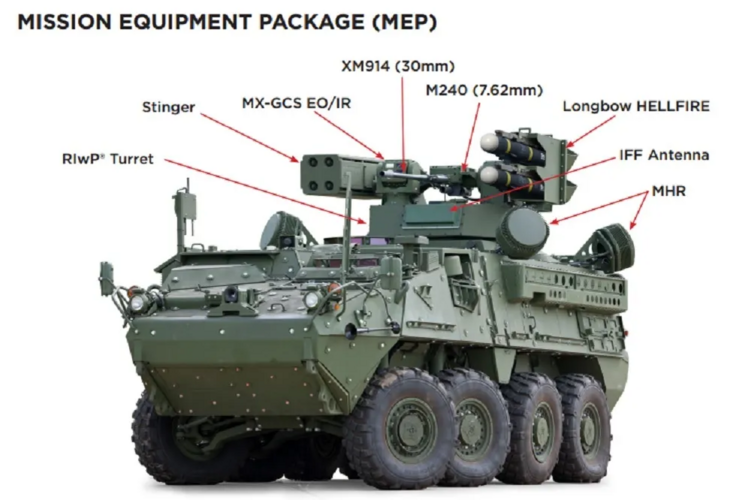
Why is this? Because it thinks it will always operate with air superiority?
No, it's the opposite. It's the expectation that they're going to be bombed by modern weapons.
The reason old weapons got killed consistently is because the air threat has consistently changed over the past 70 years during project development and development of threat aviation outstripped development of air defense systems. DIVAD was killed because it was garbage. Mauler the same. ADATS was killed because it was rather ineffective. Roland was killed due to concerns about SEAD and pilot warning (the ADA Branch has always had something of a concern about enemy pilots being alerted to targeting radars I suppose, hence its infatuation with TVM and passive infrared guidance) and because it simply came at a time when Vietnam meant things died, yet the U.S. Army still bought a battalion's worth of them.
There's a pretty clear and sharp divide in the air threat from 1990 (rather non-existent) to 2010 (cheap drones and commercial UAS with RPGs taped to them) which required substantial investments and changes to weapons that were difficult to anticipate prior.
Something like Stinger RMP II would be useless against a DJI Phantom or whatever because it was optimized for engagement of classical air threats like attack helicopters, which are slowly going extinct in the air combat arena, and fast jets which never manifest and are adequately dealt with by Patriot anyway (and typically operate above and beyond the envelopes of mobile AAA systems) whereas drones are effectively VLO targets that require new radars and new fusing to even hope to engage at conventionally lethal distances, hence the upgrades to Stinger in the early 2010's that improved its ability to engage electrically powered VLO vehicles with near-zero infrared signatures.
Not sure why people think there necessarily needs to be something between Stinger and Patriot, though, except that the gap exists. No one has won a war because of Roland, and likewise no one lost a war because they lacked it. Even without something like Rapier in Falklands the UK would have still won, and it's not like the air defense systems in that war deterred A-4Qs from hitting the beaches to any significant degree.
There has been no materialized threat that requires a longer-ranged weapon to engage things like tactical aircraft or long-range ATGW helicopters, yet cannot be engaged by Stinger (a relatively long range weapon itself at four kilometers) or Patriot. Most actual, not imaginary, threats have been from VLO close attack systems like suicide drones and spotter drones warning VBIEDs of incoming convoys to ambush. Which are beyond the scope for something like Gepard or Roland to attack, at least if Pantsir is any evidence to that. Something like ADATS would be entirely useless for the United States, whereas something like Stinger, or an even smaller missile, would be extremely important.
Perhaps there is a place for weapons like Iron Dome in providing limited zone air defense against Excalibur-style autonomous PGMs attempting to tank plink from 70 kilometers with orbital targeting, but so far I think only the United States has demonstrated this ability. Tor is rather effective at killing autonomous suicide UAS (such as HARM or loitering munitions) in Syria but I don't think it has had to tangle with something more substantial Small Diameter Bomb or JASSM yet, nor has it engaged artillery rounds like Iron Dome does. It's also more expensive so it isn't very refined, but it is a pretty old weapon.
So you have a dichotomy for hitting PGMs, small targeting or suicide UAS which act as loitering aerial VLO mines, and high flying attack ships like J-20 or F-35 that are operating well above the ordinary altitudes for man portable or lightweight battlefield systems and require significant radars to detect anyway.
None of these would be addressed by legacy-type air defense systems like Roland to any serious degree. It isn't clear what purpose Crotale/Roland has these days, or similar systems like Rapier or Pantsir, if anything at all. They perform very poorly against realistic battlefield air threats like attack drones or laser guided bombs, and they rarely see their natural prey which tends to be low altitude gunships like A-10 or AH-64 I'd imagine, so they don't really have a purpose.
Air defense is evolving towards a man portable system (possibly a very fat, long-range missile like RBS 70 with a IR guidance), a short to medium (5-20 kilometers) range anti-PGM system for attacking incoming guided munitions like GMLRS or Excalibur-type rounds, and a long-range counter-TBM/theater air defense system like PAC-3 for swatting long-range movers. Anything else is beyond the reach of battlefield air defense and dealt with by OCA tasked fighter-bombers like F-22 or F-35.
Whether CAMM-ER can replicate the job of something like Iron Dome, which has proven very effective against all manner of realistic air threats, or whether it's a system that is only good against legacy threats (attack planes, helicopters) or whatever, is an open question. Air defense systems are not a significant deterrent to attack aircraft historically, and I don't think this will change, but air defense systems can attack munitions themselves after they've been deployed. Which seems to where they're going because it probably has a better success rate, because bombs don't jink, because hit to kill is immensely viable, and because missiles with complicated ARH and advanced warheads and motors are immensely more expensive than a rocket body with just the autopilot and fins.
It's a very real concern that legacy-style weapons like ESSM/CAMM-ER and their antecedents could run out of ammunition before the enemy runs out of bombs. This already happened with Iron Dome, and a Tamir interceptor, with a range of about 10 kilometers, is an order of magnitude cheaper than a ESSM. I can't imagine CAMM-ER is any cheaper than a million a piece.
I suspect the long-term trajectory will be that short-range missiles will be increasingly simplified as guidance capabilities improve. The cost will be shifted from the rocket itself (no warhead, no onboard sensors, possibly a limited automatic pilot) to the radar/tracking system, since you'll need tons of missiles to stave off stuff like a PLAAF StormBreakeri swarm or Turkish loitering munition cloud of little solar powered anti-tank grenades. If that can't be done, well that's why people are investing in extremely powerful microwave weapons (which are little different from a radar in general), so that they can simply lock up a target and fry its computer with the same sensor/weapon system.
Conversely, long-range air defense systems will move the opposite and possibly end up being guided by AMTI space based radars with advanced automatic pilots that can handle momentary losses of communication with the guidance system (I think the largest issue with missed warshots is that missiles tend to lose a target, lose a guidance beam, or both, and revert to some default straight-runner guidance or a ballistic trajectory since old fashioned computers couldn't store enough memory) so that they can attack VLO targets at longish-range with their transient flashes of reflection. Varied methods of guidance (ranging from multiple bands of guidance radar and infrared systems, or more esoteric methods like laser guidance) would be used to overcome the multiple forms of stealth foci of future aircraft.
Short range missiles necessarily will need to be cheap because each PGM is a dead tank and a dead tank is a tremendous expense. Long range missiles will necessarily be expensive because their advanced sensors will not be allowed to be anything less due to target natures.
There isn't really a middle ground between the two dichotomies. Weapons development tends to select disruptively, in genuine high-low senses, and a system that is both mediocre in performance and still a bit too expensive to be plentiful is both manners useless. Not that CAMM-ER is worthless, as I'd imagine it's somewhere near the optimal for current decade, but in the future it will need to become cheaper.
Britain will likely replace it with a shorter range, smaller, cheaper HTK anti-PGM weapon in the vein of Iron Dome in the latter XXI.
Much like how FCS predicted the future in AFV development, I think IFCS is predicting the future of air defense, but whether it's too ambitious (America has a terrible tendency of making overly ambitious combat systems and finding out that current year's technology can't cash the checks they're writing) or not is an open question.
Colonial-Marine
UAVs are now friend, drones are the real enemy.
- Joined
- 5 October 2009
- Messages
- 1,196
- Reaction score
- 703
I think the true reason ADATS was killed was entirely budgetary. All of the trials seemed positive until the Peace Dividend came around because the Cold War was over and it was suddenly determined it was ineffective. Yet amazingly enough the Canadians bought a bunch despite their governments always under-funding their military.
Kat Tsun where I'd have to disagree with your analysis of future threats is that medium-sized UAVs out there represent a good target for a good mid-range SAM system. If you have the Patriot batteries (or hopefully Patriot's successor) worried about the thread of ballistic and cruise missiles they may not be able to afford spending a lot of missiles plinking such UAVs out of the sky. Yet short range missiles like Stinger don't have the range to reach out and get them.
I wouldn't entirely discount the utility of autocannon in contributing to short range air defense either. The intent with the 30mm chain gun on the new Stryker variant is obviously to knock out small drones with airburst shells. More capable guns and sensors could effectively give a self-propelled anti-aircraft gun a capability similar to a naval CIWS.
The big question I see is to how to integrate a combination of missiles, autocannon, directed energy weapons, and jammers into a unit. How many types of vehicles do you need to provide all of the capabilities needed?
Kat Tsun where I'd have to disagree with your analysis of future threats is that medium-sized UAVs out there represent a good target for a good mid-range SAM system. If you have the Patriot batteries (or hopefully Patriot's successor) worried about the thread of ballistic and cruise missiles they may not be able to afford spending a lot of missiles plinking such UAVs out of the sky. Yet short range missiles like Stinger don't have the range to reach out and get them.
I wouldn't entirely discount the utility of autocannon in contributing to short range air defense either. The intent with the 30mm chain gun on the new Stryker variant is obviously to knock out small drones with airburst shells. More capable guns and sensors could effectively give a self-propelled anti-aircraft gun a capability similar to a naval CIWS.
The big question I see is to how to integrate a combination of missiles, autocannon, directed energy weapons, and jammers into a unit. How many types of vehicles do you need to provide all of the capabilities needed?
- Joined
- 3 June 2011
- Messages
- 17,332
- Reaction score
- 9,067
So I guess the idea of using "hypersonic" artillery rounds as anti-aircraft/missile weapons was smothered in the crib?I think the true reason ADATS was killed was entirely budgetary. All of the trials seemed positive until the Peace Dividend came around because the Cold War was over and it was suddenly determined it was ineffective. Yet amazingly enough the Canadians bought a bunch despite their governments always under-funding their military.
Kat Tsun where I'd have to disagree with your analysis of future threats is that medium-sized UAVs out there represent a good target for a good mid-range SAM system. If you have the Patriot batteries (or hopefully Patriot's successor) worried about the thread of ballistic and cruise missiles they may not be able to afford spending a lot of missiles plinking such UAVs out of the sky. Yet short range missiles like Stinger don't have the range to reach out and get them.
I wouldn't entirely discount the utility of autocannon in contributing to short range air defense either. The intent with the 30mm chain gun on the new Stryker variant is obviously to knock out small drones with airburst shells. More capable guns and sensors could effectively give a self-propelled anti-aircraft gun a capability similar to a naval CIWS.
The big question I see is to how to integrate a combination of missiles, autocannon, directed energy weapons, and jammers into a unit. How many types of vehicles do you need to provide all of the capabilities needed?
Firefinder
ACCESS: Top Secret
- Joined
- 5 October 2019
- Messages
- 789
- Reaction score
- 1,268
More likely its one of those things that sound nice and work well in tests.So I guess the idea of using "hypersonic" artillery rounds as anti-aircraft/missile weapons was smothered in the crib?I think the true reason ADATS was killed was entirely budgetary. All of the trials seemed positive until the Peace Dividend came around because the Cold War was over and it was suddenly determined it was ineffective. Yet amazingly enough the Canadians bought a bunch despite their governments always under-funding their military.
Kat Tsun where I'd have to disagree with your analysis of future threats is that medium-sized UAVs out there represent a good target for a good mid-range SAM system. If you have the Patriot batteries (or hopefully Patriot's successor) worried about the thread of ballistic and cruise missiles they may not be able to afford spending a lot of missiles plinking such UAVs out of the sky. Yet short range missiles like Stinger don't have the range to reach out and get them.
I wouldn't entirely discount the utility of autocannon in contributing to short range air defense either. The intent with the 30mm chain gun on the new Stryker variant is obviously to knock out small drones with airburst shells. More capable guns and sensors could effectively give a self-propelled anti-aircraft gun a capability similar to a naval CIWS.
The big question I see is to how to integrate a combination of missiles, autocannon, directed energy weapons, and jammers into a unit. How many types of vehicles do you need to provide all of the capabilities needed?
But once you get into the nitty gritty of it by asking those hard questions.
Like how do you ensure that the Gun is pointed the right way in time?
How does the shell recieve the data.
How do you tie everything in.
Are you sure that the guns will be free to use it and not doing the very important work of shells a SOB into next week?
And the like.
It became unworkable.
On a ship you can plan around all that far easier then trying to get basically 2 different brigades to do so. Cause Artillery is often serpated by MILES from the ADA assets that have all the gear to use the rounds. You will basically have to double the size of an Battery of either the ADA or Arty to fit all the things together.
shin_getter
ACCESS: Top Secret
- Joined
- 1 June 2019
- Messages
- 941
- Reaction score
- 1,198
USAF logic, right there.There has been no materialized threat that requires a longer-ranged weapon to engage things like tactical aircraft or long-range ATGW helicopters, yet cannot be engaged by Stinger (a relatively long range weapon itself at four kilometers) or Patriot. Most actual, not imaginary, threats have been from VLO close attack systems like suicide drones and spotter drones warning VBIEDs of incoming convoys to ambush. Which are beyond the scope for something like Gepard or Roland to attack, at least if Pantsir is any evidence to that. Something like ADATS would be entirely useless for the United States, whereas something like Stinger, or an even smaller missile, would be extremely important.
For forces that can not count on air superiority, ISR MALE drones that flies above Stinger envelope is a relatively novel and extremely serious threat. Patriot class systems is extremely expensive, quite vulnerable and must be used with maximum care and can not provide good coverage of forward ground forces when the state of the air war is still in flux and ambush tactics is needed.
I believe that all ground forces will need AA coverage that reaches out to the limit of effective optical recon attitude as medium attitude drones eventually become omnipresent. Iranian man portable turbojet loitering AA missile or something like ought to proliferate, and it is a weapon that is clearly useful in Yemen. The US Coyote loitering munition is similarly useful development, and probably eventually become necessary for force deployments too small to have their own air task force assigned to it.
Then there is the force density problem against swarming drones: short range AA on slow platforms ultimately can not mass and can be defeated in detail by long range air munition. Air superiority is of course a great solution, but high grade air assets is also a precious asset in high end fight, and payload and range (DEW) limit sets a upper limit on defensive firepower. Long range, low cost anti-air weapon guided by air based CEC would be logical solution. Such munition can also potentially pull double duty in ground attack.
As for long range engagement against high performance VLO, I think reuse would be desirable feature and thus drones the preferred solution as sensors gets expensive very quickly. One use missile make sense when propulsion is more expensive than on board guidance, halving range cuts costs a lot. When onboard guidance is more expensive than propulsion and recovery, recovery ought to win out as not all missions require expanding the system. If the arms race in cost and performance in electronic domain grow more, SAM would actually be quite marginalized: when airplanes are cheap compared to the radar, put it on an airplane and gain benefits mobility.
It seems like a place where tactical-organization innovation could produce real performance gains here. It is like the development of mobile armored warfare, a lot of problems involve logistics, communication, training, tactics, and strategy has to be resolved before it matures and become a powerful force on the battlefield: A competition where there were clear success and failures.But once you get into the nitty gritty of it by asking those hard questions.
Like how do you ensure that the Gun is pointed the right way in time?
How does the shell recieve the data.
How do you tie everything in.
Are you sure that the guns will be free to use it and not doing the very important work of shells a SOB into next week?
And the like.
It became unworkable.
On a ship you can plan around all that far easier then trying to get basically 2 different brigades to do so. Cause Artillery is often serpated by MILES from the ADA assets that have all the gear to use the rounds. You will basically have to double the size of an Battery of either the ADA or Arty to fit all the things together.
Ceptor a.k.a CAMM is not really a spiritual successor to Rapier. It's much more Sea Wolf and the failed battlefield SAM requirement of the 1980's successor.
In this it's an anti-missile-missile and traces back in terms of concepts to earlier such efforts.
Arguably it's the final achievement of what the USN wanted from Mopsy in the 50's.
Which is why the RN came first in line for the system ahead of the Army.
As such then this delivers anti-PGM capability and arguably the next steps are to either add more rapid interceptors or cheaper more numerous interceptors.
In this it's an anti-missile-missile and traces back in terms of concepts to earlier such efforts.
Arguably it's the final achievement of what the USN wanted from Mopsy in the 50's.
Which is why the RN came first in line for the system ahead of the Army.
As such then this delivers anti-PGM capability and arguably the next steps are to either add more rapid interceptors or cheaper more numerous interceptors.
Kat Tsun
I really should change my personal text
- Joined
- 16 June 2013
- Messages
- 1,126
- Reaction score
- 1,258
USAF logic, right there.There has been no materialized threat that requires a longer-ranged weapon to engage things like tactical aircraft or long-range ATGW helicopters, yet cannot be engaged by Stinger (a relatively long range weapon itself at four kilometers) or Patriot. Most actual, not imaginary, threats have been from VLO close attack systems like suicide drones and spotter drones warning VBIEDs of incoming convoys to ambush. Which are beyond the scope for something like Gepard or Roland to attack, at least if Pantsir is any evidence to that. Something like ADATS would be entirely useless for the United States, whereas something like Stinger, or an even smaller missile, would be extremely important.
For forces that can not count on air superiority,
Not sure what you mean by "USAF thinking". It's just common sense.
They lose. End of. If you lose air superiority in the age of the F-35, you have lost. Simple as.
You should concentrate on communicating your intent to surrender to your opponent and subsequent repatriation of POWs to the homeland as expeditiously as possible. Anything less and it would be more efficient to have guys start blowing their own brains out before the enemy needs to waste a smart bomb or missile on their tanks, because that would be the effective result combat under threat of enemy air superiority would have.
Not sure why you think air defense troops need to do something besides engage the lowest altitude targets and immediate terminal threats either, outside of some bizarre parochialism that tries to deny the very basic reality that airpower is the most important means of winning wars and this has been true since WW2. Victories that have been won by troops against airpower have been done by armies that look decidedly less like the US Army, and more like the Taliban or various ethnic genocide militias of Rwanda, than anything. And bear in mind that a large force that resembled those guys recently got clobbered by F/A-18 and F-35 in Syria, with supporting cast members Su-24 and Mi-17s dropping sticks of FAB iron bombs and 55 gallon drums filled with nitrocellulose and nails, because they dared to drive around in trucks and gather in groups larger than "two or three".
Eventually all wars will be decided solely by the plinking of individual soldiers by aviation simply because the enemy had no means with which to neutralize the enemy airpower. Armies will exist solely to occupy land, wave flags around, and beat up peasantry to collect taxes. Oh, and fire mega howitzers that complement the airpower, because no one will have more than a few dozen hyper planes and a few hundred drones and that's the rich people. So army becomes the land based long-range firepower with super howitzers firing hundreds of kilometers and TBMs firing thousands, navies the sea-based long range firepower with cruise missiles and submarines zooming around, and aircraft the air-based long range firepower loitering over a target zone and enforcing borders, and all targeted by orbital satellites or something that detect when a group of guys with guns bigger than "half a dozen" "masses" on a border.
We're not quite there yet, airpower is only at the point where it can reliably plink individual foxholes with two or so people and a machine gun in it, rather than identify individual enemy troops in a crowd, but give it a bit of time.
Probably by the end of the century that will all be true.
Firepower inherently negates the principle of mass and we're approaching a point where firepower can be directed to specific individuals at specific points and places in time and space. Eventually, having a single, strong leader might even be dangerous for entire nations since that person could be easily targeted by some sort of futuristic weapon. But that's far beyond the lifespan of anyone alive today I think. Maybe it will be true in 2122.
A drone that flies above the flight regime of a Stinger or something like an Apache, which can screen battlefield troops from man-in-the-loop loitering munitions like Harops, or low altitude attack aircraft like TB-2, and can employ weapons accurately on moving targets is a tactical bomber. It should be shot down by fighters at worst and destroyed on the ground by [insert weapon here] at best.
TB-2s routinely fly below the cloud layer and necessarily so since they employ laser guided munitions. Same thing with MQ-9, which employs the same weapons as Apache, with similar restrictions. These are well within the envelope of something like Stinger. Higher up, they are relatively easily intercepted by attack helicopters with ATAS since they lack ESM or radars to tell them they are being tracked by a mmW FCR or that a helicopter is nearby. They have a little FLIR straw with a narrow FOV on a turret to look for ground targets at an indicated point on space that has been pre-designated in the mission planning briefing. If you strip all the bombs off you can carry a SAR. That's about it.
Both Harop and TB-2 probably fly around 2-5,000 feet AGL when on hunter-killer missions, which is well within the engagement envelope of Stinger, and neither have countermeasures effective against them. Easy. Ask yourself this question: If drones aren't vulnerable to MANPADS like Stinger, how else is the USAF losing combat loaded, bombed up drones to SA-7s in Yemen or Turkey losing TB-2s on ground attack runs to SA-14s in Syria? Lol.
It seems that Stinger is the most effective defense against low altitude bombers, which is all drones in their current forms are: slightly smaller and less individually scary Su-25s that can loiter in a area for 5x longer. Easy. There's your analogy: the solution is the same!
Will drones of the future resemble something different? Probably not! I don't think a Reaper drone in 2035 is going to be materially different than a Reaper drone in 2022 as far as air defense systems are concerned. Coyote, "swarming munitions" and whatnot are highly speculative and don't exist, nor have they been used in combat, so their countermeasures and capabilities are literally unknown. The only people talking about them are the only people who have to benefit from selling them, so of course they're being hyped up as the next big thing, but that has yet to be shown.
All we know is that TB-2 and MQ-9 is better at killing tanks and concentrations of Taliban than A-129 and AH-64 could ever hope to be, partly because of better mission readiness rates and partly because of drones' long loiter time allowing for greater ambiguity in target appearance periods. Instead of rotating three dozen helicopters you rotate four drones over a target area and achieve the same net result, which saves about three times the men to do the same thing in four other places where your target (whether it's a Taliban bombmaker or a TEL IRBM) might appear.
This materially doesn't change the problem: it's a low altitude, slow moving, low maneuver capacity aircraft that can be engaged by passive IR systems thanks to its high temperature turbine and lack of anti-missile countermeasures (flares). It's functionally no different than shooting at an OV-10 Bronco or IA 58 Pucara or something except those are more maneuverable and less likely to be killed by your MANPADS because they have better all-aspect, WFOV sensors (eyeballs).
Since I only speak of known facts and truths I can't speak for whether or not things like Gremlin would change this. Maybe? Maybe Gremlin, Coyote, etc. are just another in a long list of implausible projects or petty grifts by MIC contractors looking to scrap off pork money from the budget come downs of post-Afghanistan/post-Iraq. Harop seems effective but it isn't a swarming munition, just a loitering ATGW/ARM with a man in the loop capability. You might even consider it comparable to a propeller driven FOG missile.
There are probably easier ways to defeat hypothetical threats that don't exist yet than shooting them down. The current main threats are "similar but materially less demanding" of the same old, low altitude, buzzing Shturmovik with ATGW or laser guided bombs, and the somewhat more novel "self-targeting munition" that can be flown blind into a assumed laager and driven into a specific target all on demand or on the fly by an operator with a joystick. But that's more a final realization of the FOG threat of the 1980's than anything truly novel, and demands weapons that can engage PGMs.
Currently those PGMs are pretty hefty chonkers and Harop can be shot down by a Stinger with direction from a MPQ-64.
You'd almost prefer a FOG since it is substantially more difficult to track on radar, much faster (a FOG-M went like 500 miles an hour, a Harop is lucky to go half as fast, and is oodles louder to boot), and probably impossible for a man carried weapon to engage, but no one has built a LONGFOG in the 100 km class range, so it's not important. The biggest fiber optic spools are like 30 km right now, and until someone builds a Polyphem or something similar, as opposed to just bracket firing ballistic missile sized Brimstones into a target box, it's also not a problem.
When it becomes a problem then Iron Dome seems an adequate solution when mated to a proper FCR.
tl;dr It's USAF thinking because the USAF was just right about a lot of stuff. It merely got the timing wrong. Don't feel bad, the US Army was right about super howitzers and FCS MGV, it merely got the timing wrong. Admiral Rickover was right about submarines taking over the sea control role, he merely got the timing wrong. FCS is the land equivalent of the F3H's all-BVR/radar weapon set, the pre-LA class of super subs Rickover wanted with the anti-ship SLBMs, and F-89 Scorpion's anti-bomber GCI guided rocket bursts.
All the right ideas, the right conclusions, just the wrong time period, but in the end still the ultimate truth.
American military men no matter their branches, aside from perhaps the Marines who tend to be more European in outlook (although this means they are also correct about, for instance, infantry optical sights' reducing importance of belt-fed bases of fire and the relative worth of silenced automatic weapons like IAR/SAW), have a habit of being generally correct in hindsight. It just takes decades to shake out, because they're perennially optimistic about the pace of the march of technology since the end of the WW2.
They also got stuff wrong, like air-transportability being important (Army), low altitude bombing being extremely protective against SAMs (Air Force), and low radar shaping stealth being valuable for gunfire surface ships (Navy), but those wrong things (aside from the Air Force's and Navy's obsessions with low altitude penetration) have never really amounted to much in tangible damages.
But being able to operate without friendly aircraft and the only means of damaging enemy air forces is your own air defense troops, who operate extremely high visibility systems like Patriot or Avenger, is a sure sign of an imminent and painful defeat. Luckily the USAF realizes this and so does the Army, so protection of the airbases by ground troops and destruction of enemy air forces is part of their primary responsibilities.
Last edited:
BB1984
I really should change my personal text
- Joined
- 21 August 2011
- Messages
- 121
- Reaction score
- 185
There's a lot of good stuff about the value of air superiority in the post, but air superiority is not always a matter of "either you have it and win or the enemy does and you lose." That false dichotomy may be what was meant by "USAF thinking"USAF logic, right there.There has been no materialized threat that requires a longer-ranged weapon to engage things like tactical aircraft or long-range ATGW helicopters, yet cannot be engaged by Stinger (a relatively long range weapon itself at four kilometers) or Patriot. Most actual, not imaginary, threats have been from VLO close attack systems like suicide drones and spotter drones warning VBIEDs of incoming convoys to ambush. Which are beyond the scope for something like Gepard or Roland to attack, at least if Pantsir is any evidence to that. Something like ADATS would be entirely useless for the United States, whereas something like Stinger, or an even smaller missile, would be extremely important.
For forces that can not count on air superiority,
Not sure what you mean by "USAF thinking". It's just common sense.
They lose. End of. If you lose air superiority in the age of the F-35, you have lost. Simple as.
You should concentrate on communicating your intent to surrender to your opponent and subsequent repatriation of POWs to the homeland as expeditiously as possible. Anything less and it would be more efficient to have guys start blowing their own brains out before the enemy needs to waste a smart bomb or missile on their tanks, because that would be the effective result combat under threat of enemy air superiority would have.
Not sure why you think air defense troops need to do something besides engage the lowest altitude targets and immediate terminal threats either, outside of some bizarre parochialism that tries to deny the very basic reality that airpower is the most important means of winning wars and this has been true since WW2. Victories that have been won by troops against airpower have been done by armies that look decidedly less like the US Army, and more like the Taliban or various ethnic genocide militias of Rwanda, than anything. And bear in mind that a large force that resembled those guys recently got clobbered by F/A-18 and F-35 in Syria, with supporting cast members Su-24 and Mi-17s dropping sticks of FAB iron bombs and 55 gallon drums filled with nitrocellulose and nails, because they dared to drive around in trucks and gather in groups larger than "two or three".
Eventually all wars will be decided solely by the plinking of individual soldiers by aviation simply because the enemy had no means with which to neutralize the enemy airpower. Armies will exist solely to occupy land, wave flags around, and beat up peasantry to collect taxes. Oh, and fire mega howitzers that complement the airpower, because no one will have more than a few dozen hyper planes and a few hundred drones and that's the rich people. So army becomes the land based long-range firepower with super howitzers firing hundreds of kilometers and TBMs firing thousands, navies the sea-based long range firepower with cruise missiles and submarines zooming around, and aircraft the air-based long range firepower loitering over a target zone and enforcing borders, and all targeted by orbital satellites or something that detect when a group of guys with guns bigger than "half a dozen" "masses" on a border.
We're not quite there yet, airpower is only at the point where it can reliably plink individual foxholes with two or so people and a machine gun in it, rather than identify individual enemy troops in a crowd, but give it a bit of time.
Probably by the end of the century that will all be true.
Firepower inherently negates the principle of mass and we're approaching a point where firepower can be directed to specific individuals at specific points and places in time and space. Eventually, having a single, strong leader might even be dangerous for entire nations since that person could be easily targeted by some sort of futuristic weapon. But that's far beyond the lifespan of anyone alive today I think. Maybe it will be true in 2122.
A drone that flies above the flight regime of a Stinger or something like an Apache, which can screen battlefield troops from man-in-the-loop loitering munitions like Harops, or low altitude attack aircraft like TB-2, and can employ weapons accurately on moving targets is a tactical bomber. It should be shot down by fighters at worst and destroyed on the ground by [insert weapon here] at best.
TB-2s routinely fly below the cloud layer and necessarily so since they employ laser guided munitions. Same thing with MQ-9, which employs the same weapons as Apache, with similar restrictions. These are well within the envelope of something like Stinger. Higher up, they are relatively easily intercepted by attack helicopters with ATAS since they lack ESM or radars to tell them they are being tracked by a mmW FCR or that a helicopter is nearby. They have a little FLIR straw with a narrow FOV on a turret to look for ground targets at an indicated point on space that has been pre-designated in the mission planning briefing. If you strip all the bombs off you can carry a SAR. That's about it.
Both Harop and TB-2 probably fly around 2-5,000 feet AGL when on hunter-killer missions, which is well within the engagement envelope of Stinger, and neither have countermeasures effective against them. Easy. Ask yourself this question: If drones aren't vulnerable to MANPADS like Stinger, how else is the USAF losing combat loaded, bombed up drones to SA-7s in Yemen or Turkey losing TB-2s on ground attack runs to SA-14s in Syria? Lol.
It seems that Stinger is the most effective defense against low altitude bombers, which is all drones in their current forms are: slightly smaller and less individually scary Su-25s that can loiter in a area for 5x longer. Easy. There's your analogy: the solution is the same!
Will drones of the future resemble something different? Probably not! I don't think a Reaper drone in 2035 is going to be materially different than a Reaper drone in 2022 as far as air defense systems are concerned. Coyote, "swarming munitions" and whatnot are highly speculative and don't exist, nor have they been used in combat, so their countermeasures and capabilities are literally unknown. The only people talking about them are the only people who have to benefit from selling them, so of course they're being hyped up as the next big thing, but that has yet to be shown.
All we know is that TB-2 and MQ-9 is better at killing tanks and concentrations of Taliban than A-129 and AH-64 could ever hope to be, partly because of better mission readiness rates and partly because of drones' long loiter time allowing for greater ambiguity in target appearance periods. Instead of rotating three dozen helicopters you rotate four drones over a target area and achieve the same net result, which saves about three times the men to do the same thing in four other places where your target (whether it's a Taliban bombmaker or a TEL IRBM) might appear.
This materially doesn't change the problem: it's a low altitude, slow moving, low maneuver capacity aircraft that can be engaged by passive IR systems thanks to its high temperature turbine and lack of anti-missile countermeasures (flares). It's functionally no different than shooting at an OV-10 Bronco or IA 58 Pucara or something except those are more maneuverable and less likely to be killed by your MANPADS because they have better all-aspect, WFOV sensors (eyeballs).
Since I only speak of known facts and truths I can't speak for whether or not things like Gremlin would change this. Maybe? Maybe Gremlin, Coyote, etc. are just another in a long list of implausible projects or petty grifts by MIC contractors looking to scrap off pork money from the budget come downs of post-Afghanistan/post-Iraq. Harop seems effective but it isn't a swarming munition, just a loitering ATGW/ARM with a man in the loop capability. You might even consider it comparable to a propeller driven FOG missile.
There are probably easier ways to defeat hypothetical threats that don't exist yet than shooting them down. The current main threats are "similar but materially less demanding" of the same old, low altitude, buzzing Shturmovik with ATGW or laser guided bombs, and the somewhat more novel "self-targeting munition" that can be flown blind into a assumed laager and driven into a specific target all on demand or on the fly by an operator with a joystick. But that's more a final realization of the FOG threat of the 1980's than anything truly novel, and demands weapons that can engage PGMs.
Currently those PGMs are pretty hefty chonkers and Harop can be shot down by a Stinger with direction from a MPQ-64.
You'd almost prefer a FOG since it is substantially more difficult to track on radar, much faster (a FOG-M went like 500 miles an hour, a Harop is lucky to go half as fast, and is oodles louder to boot), and probably impossible for a man carried weapon to engage, but no one has built a LONGFOG in the 100 km class range, so it's not important. The biggest fiber optic spools are like 30 km right now, and until someone builds a Polyphem or something similar, as opposed to just bracket firing ballistic missile sized Brimstones into a target box, it's also not a problem.
When it becomes a problem then Iron Dome seems an adequate solution when mated to a proper FCR.
tl;dr It's USAF thinking because the USAF was just right about a lot of stuff. It merely got the timing wrong. Don't feel bad, the US Army was right about super howitzers and FCS MGV, it merely got the timing wrong. Admiral Rickover was right about submarines taking over the sea control role, he merely got the timing wrong. FCS is the land equivalent of the F3H's all-BVR/radar weapon set, the pre-LA class of super subs Rickover wanted with the anti-ship SLBMs, and F-89 Scorpion's anti-bomber GCI guided rocket bursts.
All the right ideas, the right conclusions, just the wrong time period, but in the end still the ultimate truth.
American military men no matter their branches, aside from perhaps the Marines who tend to be more European in outlook (although this means they are also correct about, for instance, infantry optical sights' reducing importance of belt-fed bases of fire and the relative worth of silenced automatic weapons like IAR/SAW), have a habit of being generally correct in hindsight. It just takes decades to shake out, because they're perennially optimistic about the pace of the march of technology since the end of the WW2.
They also got stuff wrong, like air-transportability being important (Army), low altitude bombing being extremely protective against SAMs (Air Force), and low radar shaping stealth being valuable for gunfire surface ships (Navy), but those wrong things (aside from the Air Force's and Navy's obsessions with low altitude penetration) have never really amounted to much in tangible damages.
But being able to operate without friendly aircraft and the only means of damaging enemy air forces is your own air defense troops, who operate extremely high visibility systems like Patriot or Avenger, is a sure sign of an imminent and painful defeat. Luckily the USAF realizes this and so does the Army, so protection of the airbases by ground troops and destruction of enemy air forces is part of their primary responsibilities.
The classic modern example is the '73 Arab-Israeli war, where SAM systems denied (or at least severely degraded) the IAF but that did not translate into air superiority for the Arabs. In a peer, or near-peer, conflict air space could be contested (think Eastern front in '43) or a denial strategy may be still be possible, though it's trickier in the drone era.
Speaking of peer/near-peer conflict, the "low and fast" strategy was developed for war with a peer (USSR) that deployed a dense and overlapping series of SAM defenses but not any formidable AWACS / look-down-shoot-down capabilities. In this environment, high speed, low level penetration makes a lot of sense (and still would) because high altitude work was extraordinarily dangerous.
In the actual wars fought recently, the situation inverted: the few (if any) big SAM systems and IADS capable of work at altitude proved relatively easy to destroy or degrade but the low altitude systems (esp MANPADS) proved very difficult to eliminate. Applying the low and fast penetration approach in this environment is deeply misguided and, combined with the prolific use of PGM, leads to strange situations, such as the ideal CAS tool for A-stan being, IMHO, the old maritime patrol aircraft (long endurance, large crew to closely monitor sensors and a complex ground situation, and big bomb load).
Kat Tsun
I really should change my personal text
- Joined
- 16 June 2013
- Messages
- 1,126
- Reaction score
- 1,258
There's a lot of good stuff about the value of air superiority in the post, but air superiority is not always a matter of "either you have it and win or the enemy does and you lose." That false dichotomy may be what was meant by "USAF thinking"
It's not a false dichotomy...
The US Army isn't set up to fight like the Vietnamese or Taliban and neither of those are particularly good models for invading foreign countries like America does, and Afghanistan and Vietnam don't. They are inherently defensive organizations built for fighting imperialist occupations of their homelands. Imperialist occupiers are rather obvious and stick out in a crowd, much less from the air, with their foreign built war machines and bizarre looking grid-layout base camps with giant invader flags and diesel generators where the nearby native village is predominantly adobe-type detached homes or Ba'athist concrete apartments...
The PLA in 1950 might be the only example, but again is a local force fighting against invaders, rather than an imperialist expeditionary force.
Never mind the greatest observation method in 1950 was the human eyeball. Things are different now, so something like a PLA formation would be detected and destroyed simply because a mass of men moving in conventional parade formation is a very obvious military target, but it's much harder to determine if that Pashtun group of four people that's moving across the Durand Line is a family going to a wedding, someone coming back from a wedding, or a Taliban group with a man packed DShK hiding in those baskets.
Not that it stopped the USAF or CIA, I guess, but they rather reluctantly became more selective in their targeting. So yes, it's entirely possible for light infantry to defeat air superiority. Too bad for the US Army it isn't, and literally can never be, organized in such a manner. Otherwise it would make its wild gesticulations and genuine concerns about air superiority actually unimportant.
So yes. It's a false dichotomy in the sense that in some hypothetical, non-existent, and historically ignorant approach might mean in a fantasy world the US Army can ignore it. It's not a false dichotomy in the sense of the real, actual historical inertia behind American military development, and requirements of the US Army as being the expeditionary forces of a global empire.
A US Army battalion is about as obvious as a Roman Legion or a British regiment of foot. This is by design, as hiding it in plain sight would defeat one of its primary purposes anyway: deterrence through presence.
The mere existence of light infantry forces that can successfully repel imperialist invaders through attritionism and diplomatic maneuvering due to the indecision and lack of significant resolve of their opponents does not adequately disprove the idea that any of the UNSC's P5, or any major industrialized military, lacking air superiority is an instant defeat.
ISIS proves that you don't even need to be a country to be bombed to death. You merely need to drive around in trucks. The Taliban also prove that when the enemy air force is completely neutralized, as the ANA was, this is a completely valid tactic to conquest. ISIS proves that when the enemy air force shows up and maintains a sustained bombing campaign, it is a completely suicidal one.
As always, successful tactics only exist within the realm of individual organizations and cultures relative power dynamics and historical inertia. What is successful for one person in one specific scenario is suicidal if copied by another person in a similar scenario. Not the least, albeit not related to air power, is the 2003 Battle of Fallujah versus the 1994 Battle of Grozny. One side attempted a mere repeat of the latter, while the other side anticipated this and successfully duped the opponent, successfully destroying the enemy where the prototype of such methods (modern mechanized combat in urban terrains) was much more attritional.
It's merely a skill issue thing.
The classic modern example is the '73 Arab-Israeli war, where SAM systems denied (or at least severely degraded) the IAF but that did not translate into air superiority for the Arabs. In a peer, or near-peer, conflict air space could be contested (think Eastern front in '43) or a denial strategy may be still be possible, though it's trickier in the drone era.
At no point during 1973 did Israel lose air superiority.
Much like the Falklands War and the Argentines, it faced some minor opposition in well operated SAM systems that it had little experience in dealing with and hampered some attacks more than they would have liked, but not impossibly so. Unlike the Falklands there was no opposing air force to actually stop the bombers or kill the pilots in large numbers. Unlike the Falklands, an OCA effort was completely possible, but also entirely unnecessary as the Egyptian Air Force was a total no-show.
None of these advantages were decisive for the Egyptians, as they lost, and the Israelis won, which proves the point I made: air superiority cannot be won without opposing air power directly, and air defenses do not oppose air power directly. They mitigate losses from damages by air strikes, which increases virtual attrition on a fighter wing, but they don't appreciably contribute to real attrition. That's what the mass OCA strike that obliterates 100-150 aircraft in a major raid on the local TFW's staging base does.
This is most obvious as the Syrian attacked Golan Heights suffered from similar threats of SA-6 attack, yet suffered their most egregious losses from ZSU-23-4. Hundreds of missiles from SA-6 and SA-2 were fired on both fronts and shot down a couple airplanes. SAMs aren't a huge threat in general, but those that are are usually the smallest and tiniest ones, such as Stingers and SA-7s, rather than the big and obvious ones, like Gammon or Kub.
1973 was "contested" air superiority. The SAM systems made flexing air superiority more difficult, but never actually stopped it, because the Israelis never stopped strikes on Egyptian troops. The Ostfront is what the USAF would call air parity, writ large. This is what happens when two air forces that are bad at OCA meet each other. It devolves to pure attrition and larger macroeconomic factors come into play. OCA is accomplished by ground forces seizing airbases and liquidating ground crews and aircraft with machine guns and cannon fire.
It's important to remember that for every aircraft shot down, the Egyptian Air Defense Troops fired 380 missiles. The much better operated and trained Vietnamese Air Defense Troops were about half that. Pretty terrible, but SAMs are doing something unnatural for them, as in it's a rather rubbish waste of money and resources, when they try to engage airplanes. People might whinge about "Western air defenses being weak" because it's composed of silly Oerlikon 35mms and Bofors L/70s with HEAB rounds and Stingers or IRIS-T or CAMM, which aren't sexy (I guess). But this is rather strikingly similar to the same bizarre anxieties that struck the "Cruiser gap" folks, you know the ones that complained about Spruance and Ticonderoga being "underarmed" compared to Soviet equivalents; i.e. a simple refusal to understand or perhaps innocent ignorance of the basic fundamentals.
Big missiles simply aren't good at killing planes when launched from big trucks. This seems to be a relatively complex issue stemming from the long number of events that must go well for big missiles fired from a big truck to hit a plane. Any single hiccup in this long series of events from identification, tracking, acquisition, launching, guiding, interception, confirmation of kill, that can be invoked by either side "kills" the entire "chain" and the entire effort is wasted, from building those rockets, to putting them in trucks, to training the operators. You might as well ask yourself what it all was for.
SAMs are much more effective at engaging munitions than planes. Which goes back to SAMs adding virtual attrition to strike planners. They increase overhead. When they exceed the cost of overhead for an air force, they don't defeat it, they merely add attritionist factors. If your economy can absorb the economic costs of firing approximately equivalent to thrice as much money per plane killed in rockets, and perhaps similar amounts in personnel training, then you will win.
But what economy can do that against the United States, the largest economy in the world with the best airplanes? Perhaps there will be some new RMA that ends up like the atomic bomb or like stealth airplanes or whatever and shoves manned airplanes out of the game as decisively as atom bombs shoved big field armies out and stealth planes shoved big SAM networks out.
But it won't be bigger truck launched missiles.
It will be something more oblique that neutralizes things like the major theater airbase or reduces the cost of aircraft. Like robot stealth bombers or something that can fly twice as long as a conventional bomber like F-35 or F-22 per lifetime hours percentage (conventional aircraft fly 4-5% of their flight hours of ownership, RPAs fly ~20%, and presumably a jet powered RPA can manage ~8-10%, which would be fairly significant). Or perhaps it will be orbital infrared scanning that targets supercruising stealth bombers like F-22 from above, attacking them with orbit based interceptor missiles. Who knows.
Naturally countermeasures to both of these potential futures, namely dispersion of F-22/JSF forces by roadside airbase and potential servicing by special forces ground crews in Hercules transports, and designing future combat stealth aircraft to cruise in the lower subsonic regimes for longer periods rather than fly quickly to a target area shortly after takeoff which are already being built into the next generations of aircraft (B-21), are already here.
tl;dr Air superiority is important because the US Army presumably wants to fight other industrialized countries with powerful weapons. If the US Army has any purpose in the world, and one which Liberty Air Defense System and ADATS would have a purpose, it is to defeat other industrial nations in armed combat by killing more of the enemy than they are themselves killed. By its natural this excludes any organization which negates air superiority, because these organizations are not effective at fighting outside of extremely limited geographies.
You can ask yourself why the Crips or Bloods haven't invaded Japan or Britain and raised their banners over Tokyo or London if you want an example ad absurdum. The most difficult to locate air target for a bombing raid is a street gang selling drugs in a high school locker room: it uses civilians as shields, it is impossible to determine from a glance who is who, and it requires significant on-the-ground knowledge to sift facts from rumors.
Conversely the most obvious air target is a naval battlegroup or perhaps a tank battalion moving across the open desert in a close formation and communicating in UHF/VHF open comms. It can be seen, literally and electronically, from orbit. It can be targeted by flying aircraft trivially. It cannot make any effort to hide its presence even if it had wanted to without inherently dissolving itself. Now for some reason I am getting deja vu.
Which one is more relevant to what the US Army does? Does it sell drugs in a locker room or does it do tank attacks in the desert?
Centralizing organization and force structure in major theater air bases is a great way to mass airpower rapidly and maintain planes with fewer numbers of personnel, but this is the exact opposite of what a fight between two "big" countries would look like. Firepower inherently requires greater dispersion. Conversely, insurgencies represent the opposite of firepower: they are not individually dangerous but they are prolific and present even without physical or tangible evidence. All security measures must be taken in a insurgent campaign because you simply do not know if insurgents lurk within, without, or do not exist, because if you did, there would never be an insurgency to begin with.
Major airbases and centralized organization like represented by large air defense systems such as Patriot and S-400 are great for lower intensity combats. They can defend against TBMs and small air attacks. They are wholly incapable of stopping major, determined air raids, as proven by history.
If I have to fight the Soviet Air Force and it's 198X I would feel much safer and confident in my ability to inflict casualties for a longer period with 30 airbases with half a dozen planes a piece and nothing but Stingers and the occasional Bofors gun than I would with 3 airbases with a TFW a piece and a battery of Patriot missiles. I'd wager the latter would be cheaper too but that probably requires infrastructure already existing. High capital cost, and if the bases have be upgraded it's even worse, so centralization saves money in the short run.
This is why the Swedish Bas 90 model was and remains the preeminent archetype for combat of major industrialized air forces under nuclear conditions, incidentally. Many have tried to copy it since and few have succeeded.
Last edited:
Similar threads
-
-
Oerlikon GDF-DO3 35mm 'Escorter' Self-propelled anti-aircraft gun system
- Started by Pioneer
- Replies: 22
-
Erprobungsträger mit 3-achs Stabilisiertem Turm
- Started by Jason Dykstra (Wyvern)
- Replies: 32
-
-

